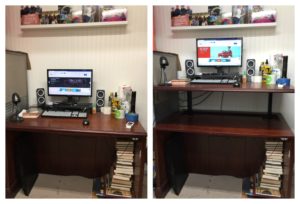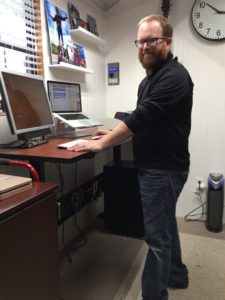Sit and Stand Desks, Balance Boards, and a Bit of Science
Last week I wrote about my treadmill desk and the benefits I gain from an active day of office work. It still blows my mind that I have been walking and working on a treadmill desk for five years…time flies! This week I wanted to share a bit about the sit and stand desks I use in the shop at home and a bit about the science behind improved brain function and active work stations. Remember, “Dad is Learning” and I’m really curious…
They go by a variety of names – sit and stand, sit-stand, height adjustable – but this style of desk offers options for easily working from either a sitting or standing position. (If only my children were so accurately labeled.) Standing desks have been around for a long time. Ernest Hemingway and Donald Rumsfeld both used standing desks. Today’s sit-stand desks have become popular after a wave of research suggesting that ‘too much sitting is killing you.’
I purchased both of my sit and stand desks at a local office auction. One is a HEAVY piece of furniture that looks like a standard desk until the electric motors glide the desktop upward. I think I paid about 10% of the retail price for that desk. My other desk is fairly basic with a wide work surface and two small leg columns that contain electric motors. I paid less than $100 for each of my desks. A quick search of Dallas Craigslist shows used electric sit and stand desks for as low as $150. But, you can try out the standing desk for even less…
- One of my favorite places to read while I was in grad school (pre-treadmill desk) was standing at our kitchen counter. Part of the counter is the standard 36” height but a portion is elevated to 44” which is perfect for standing an reading.
- There are lots of creative ways to elevate your work surface with household items – books, boxes, even this clever IKEA furniture hack that can get you standing for $22.
- Lots of options exist for modifying a standard desk. A friend had a Varidesk platform – a sit and stand desk platform that sits on the surface of a standard desk. They are very stable and well thought out. There are also all sorts of monitor arm mounts that can include a tray for your laptop. Just search Pinterest and you’ll find something that works for you…but wait till you’ve finished this post
Classrooms and Activity Permissive Learning Environments
Teachers have embraced the idea of non-traditional work surfaces for a long time. Activity Permissive Learning Environments is a term developed by Texas A&M University researchers. Basically, after years of telling kids to sit still some teachers are inviting movement as a part of facilitating learning. A quick trip through the interwebs will turn up a large number of genius ideas that cost next to nothing.
- Tire tubes tied between desk legs to help with foot fidgets.
- Milk crates containing a large bouncy ball to provide an active seating option.
- Treadmills or exercise bikes transformed from a clothes rack in the bedroom at home to an active reading station that can be used as a reward in the classroom. Many teachers found that the active option increased interest in reading among boys.
- A simple balance board made from a plank of wood and a large dowel.
The PTA at our school shares a workspace with a reading therapist on campus. Being curious, I was checking out her collection of balance boards the other day. Next time I saw her, I asked about the benefits of using the balance boards in her work. This post would be too long if I shared all that she told me, but here is the main point – The system that helps us balance (vestibular system) can help our brains work better when it is activated. Using the balance board activates both hemispheres of the brain which allows for better comprehension, improved eye tracking, and faster learning. (Tip: Want to brighten the day of an educator? Ask them a question about teaching and you will give them an opportunity to share some of the passion that drives their work.) If you want to learn more about the research, check this out.
Classroom equipment catalogs are now filled with all sorts of active seating options, sit and stand desks (complete with swinging foot bars), under desk pedal cycles, and plenty of other options. It appears only the cutting edge schools are fully embracing the technology at this point. Updating even one classroom would cost thousands of dollars for a set of tools that hasn’t been fully researched.
Adults using sit and stand desks are starting to embrace the new concepts. A growing field of manufacturers are making balance boards for the workplace. The toughest part of working at a standing desk is the foot fatigue and I could see a balance board being a big help. I’m always on the move when I’m at my sit and stand desks. One is used exclusively with my eBay business and the other provides a quiet space at home where I can read, write, or finish building a lesson. I don’t see a balance board in my future but they do appear to be a great option.
The Research
 In all honesty, the jury is still out regarding the benefits of treadmill desks, sit and stand desks, etc. A quick Google search will turn up articles with sensational headlines – Experts Say Your Standing Desk Is Basically Useless. The article actually says that there isn’t a research pool big enough to draw a solid conclusion (gotta love those HuffPo click bait titles.)
In all honesty, the jury is still out regarding the benefits of treadmill desks, sit and stand desks, etc. A quick Google search will turn up articles with sensational headlines – Experts Say Your Standing Desk Is Basically Useless. The article actually says that there isn’t a research pool big enough to draw a solid conclusion (gotta love those HuffPo click bait titles.)
There are several research projects exploring the benefits of an active workplace. Texas A&M and Harvard are exploring the benefits of standing desks in the office and the classroom. Among other things, standing desks are thought to help with obesity, cancer, and brain function.
In my personal experience, I think better on my feet. Whether I am standing or walking, productivity is better and my mind is clearer. It will be interesting to see what the research discovers in the coming years. Is a standing desk or treadmill desk in your future?



Jon, a quick inexpensive fix for learning- exercise ball. When Justin was in public school, it was in his IEP from his therapists to have him sit on an excercise ball at his desk to help his brain function (because of the scar tissue on his brain from his surgeries). This was before all the fancy wiggle seats and such. Jen and I use it at home from time to time as well and it helps us focus and learn better. I’m considering getting some for my Wednesday night Bible class as well.